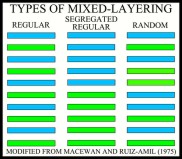

 |
 |
 Mixed-layer
clay minerals are materials in which different kinds of clay layers alternate
with each other. The mixing or interstratification in vertical stacking
can be regular (ordered), segregated regular, or random (MacEwan and Ruiz-Amil,
1975; Reynolds, 1980; Wilson, 1987). Commonly described mixed-layer clays
include: illite-vermiculite, illite-smectite, chlorite-vermiculite (corrensite),
chlorite-smectite, and kaolinite-smectite. Mixed-layer clays can form by
weathering involving the removal or uptake of cations (e.g. K), hydrothermal
alteration, or removal of hydroxide interlayers, and, in some cases, may
represent an intermediate stage in the formation of swelling minerals from
non-swelling minerals or visa versa (MacEwan and Ruiz-Amil, 1975; Sawhney,
1989).
Mixed-layer
clay minerals are materials in which different kinds of clay layers alternate
with each other. The mixing or interstratification in vertical stacking
can be regular (ordered), segregated regular, or random (MacEwan and Ruiz-Amil,
1975; Reynolds, 1980; Wilson, 1987). Commonly described mixed-layer clays
include: illite-vermiculite, illite-smectite, chlorite-vermiculite (corrensite),
chlorite-smectite, and kaolinite-smectite. Mixed-layer clays can form by
weathering involving the removal or uptake of cations (e.g. K), hydrothermal
alteration, or removal of hydroxide interlayers, and, in some cases, may
represent an intermediate stage in the formation of swelling minerals from
non-swelling minerals or visa versa (MacEwan and Ruiz-Amil, 1975; Sawhney,
1989).
Regularly interstratified structures are readily identified by their
001 basal reflection, which corresponds to the sum of the spacings of the
individual components, and subsequent peaks of higher integral orders (Sawhney,
1989). For example, regularly interstratified illite-smectite, when Mg-saturated
and glycolated, would be characterized by a 001 diffraction peak at about
27 angstroms, corresponding to the sum of the spacings of illite (10 angstroms)
and smectite (17 angstroms). Conversely, randomly interstratified structures
have non-integral peaks at positions intermediate between the peaks from
the individual mineral layers. For example, randomly interstratified illite-chlorite
would be characterized by a 001 basal diffraction peak between 10 and 14
angstroms.
| X-ray powder diffraction patterns of oriented-aggregate mounts showing the effects of standard treatments on Chlorite-Vermiculite: | |
Selected Bibliography
for Mixed-Layer Clays